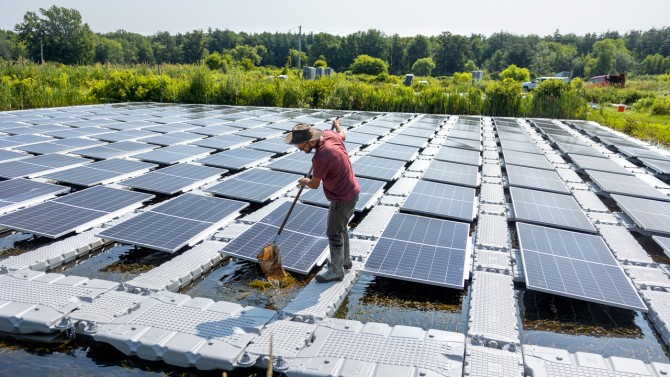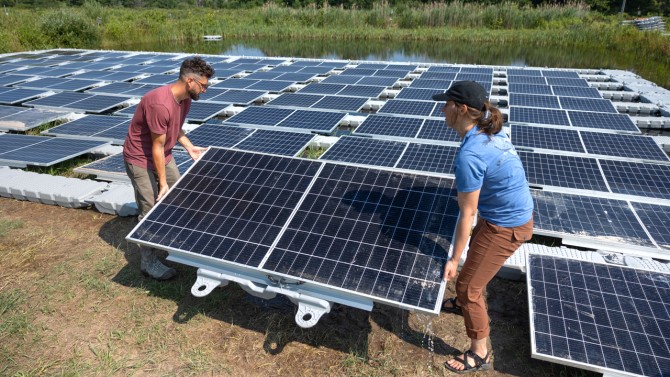Earth is running out of room.
Modern society demands food and sustainable energy, so science has an idea: To preserve agricultural land for crops and conservation lands for wildlife, place floating photovoltaic panels on lakes, rivers and reservoirs.
The problem: No one has fully defined how acres of panel-topped bodies of water affect biologic aquatic systems, but Cornell and U.S. Geological Survey ecologist Steve Grodsky – and a multidisciplinary team of researchers – soon will learn.
Steve Grodsky, assistant professor, samples arthropods on a solar panel-covered pond at the Cornell Experimental Pond Facility.
Since the middle of June, Grodsky and a small group of students have linked 378 solar panels and 1,600 floats – by hand, one-at-a-time – across three ponds at the Cornell Experimental Pond Facility, adjacent to the Ithaca airport. The three-year project is funded by the Cornell Atkinson Center for Sustainability.
“We need renewable energy to mitigate climate change, and we need room to grow food and support ecosystem services,” said principal investigator Grodsky, assistant professor (courtesy) of natural resources and the environment in the College of Agriculture and Life Sciences, and a faculty fellow at Cornell Atkinson. “If we partially cover lakes and reservoirs with solar panels, how can we do it in a smart, sustainable way? That’s what we’re going to find out.”
Specifically, the project will examine how floating solar panels on the research ponds affect the abiotic and biotic parts of water; and how microbes, macroinvertebrates (snails and crayfish), macrophytes (aquatic plants) and fish fare. The researchers will track the ponds’ greenhouse gas emissions, summertime algae growth, bioacoustics and environmental DNA.
Cornell scientists joining Grodsky as co-principal investigators are:
- Meredith Holgerson, assistant professor of ecology and evolutionary biology (CALS), whose research indicates that ponds are known to emit carbon dioxide and methane;
- Marian Schmidt, assistant professor of microbiology (CALS), who will study how the panels affect the microbial ecology in the ponds;
- Aaron Rice, researcher, K. Lisa Yang Center for Conservation Bioacoustics, at the Cornell Lab of Ornithology (CALS), who will help examine how the panels affect the bioacoustics in the ponds.
Ciel & Terre, a French company that specializes in developing floating solar panels, is partnering with the researchers. The company has deployed about 280 such projects around the world.
Grodsky said interest in water-borne solar panels is rising. Last December, Rep. Paul Tonko (D-New York) and Rep. Jared Huffman (D-California) introduced the “Protect our Waters and Expand Renewables on our Reservoirs Act,” known as the “POWER our Reservoirs Act,” which would spare land, possibly reduce harmful algal blooms, advance clean energy production on federal water reservoirs and examine the deployment of floating solar to create renewable energy.
Citing reports from the National Renewable Energy Laboratory, the proposed law said that deploying floating solar panels on reservoirs could save 5 million acres of land and meet 10% of the country’s electricity needs.
While Grodsky would have preferred to link these solar panels to the electric grid, it was too expensive for this project.
Ponds naturally release greenhouse gases as organic matter in the water grows and dies.
Adding solar panels to a pond in July, Steve Grodsky, left, and doctoral student Caitlin Davis aim to understand how floating photovoltaic panels affect the biology of the water.
In late July, postdoctoral researcher Nicholas Ray, masters student Tess Canino and Jera Jansen ’25 began to examine the carbon dioxide, methane and nitrous oxide concentrations emanating from the ponds.
“If we can understand the scientific implications for floating solar, we have an opportunity for energy production with a possibly low environmental footprint,” said Ray, who works in Holgerson’s lab.
On nearby control ponds, Canino – whose background is in forestry – kayaked out to read the gas-trapping monitors and call out the measurements. “I’m not sitting in an armchair,” they said. “This contributes to conservation efforts. This boots-on-the-ground research is applicable to our current global crisis and it can help mitigate the impact of climate change.”
From a sustainability perspective, it’s important to understand the effects on ecosystems, Grodsky said: “It’s not about slowing down renewable energy development; it’s about incorporating scientific rigor to make the deployment of floating solar development more sustainable.”
With today’s energy transitioning to renewable, science must incorporate sustainability from the start, Grodsky said. “If we dive right in, we may find unintended consequences down the road. We need renewable energy to mitigate climate change, but how can we do it in a smart, sustainable way?”
In addition to Ray, Canino and Jansen, assisting with the panel construction on the ponds were: Tim Boycott, Trifosa Simamora and Caitlin Davis doctoral students in natural resources and the environment; Sheen Dwyer-McNulty ’23; and Dave Grodsky.








